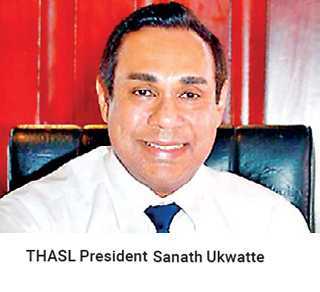Thursday Jan 23, 2025
Thursday Jan 23, 2025
Friday, 11 October 2019 00:10 - - {{hitsCtrl.values.hits}}
By Charumini de Silva
The Hotels Association of Sri Lanka (THASL) yesterday estimated occupancy levels to decline by 50% this winter season over the corresponding period last year, as the industry counted rising losses in the aftermath of the Easter Sunday attacks.
“We are not too optimistic about the upcoming winter season. There is a major drop in occupancy levels already. We are expecting a 30-50% decline compared to the same season a year ago,” THASL President Sanath Ukwatte told the Daily FT.
He said that they were unable to plan ahead, with Presidential Elections scheduled for the middle of next month.
“We still don’t know how the foreign missions in the country will react to the upcoming presidential election. We will only be able to start campaigning after the elections. Until such time, we will have to monitor the situation,” Ukwatte asserted.
He also noted that hotels were back to square one after the Bohra International Convention held in Colombo.
“Thank goodness for the Bohra Convention; overall hotels had some business even for a short period. Now the hotel occupancy levels have dropped to 30%,” he said.
Tourist arrivals fell 27.2% in September from a year ago, marking the first month-on-month decline since May this year. Previously, following the Easter Sunday tragedy, tourist arrivals rose from 37,802 in May to 63,072 in June, and then to 115,701 in July and 143,587 in August, official data revealed.
“Hotels are still in a crisis,” Ukwatte said, adding that there were no improvements in occupancy levels or room rates.
He noted that hotel revenue was generated through consolidation of the domestic market.
“Most of hotels and resorts are able to be in business thanks to local travellers, with the majority of these entities making money during weekends,” he added.
However, Ukwatte pointed out that there had been reduced aggregate demand across all sectors within the tourism industry.
According to official data, tourist arrivals during the first nine months of the year had fallen 20.5% year-on-year to 1.37 million, and the largest source market for tourists in September was India, followed by China and the United Kingdom.
Despite Sri Lanka currently confronting a significant challenge to reach the targeted 2.1 million tourists, with only three months left to attract over 720,000 travellers, authorities are confident of achieving these volumes.
Sri Lanka ended 2018 with 2.33 million tourists, up by 10.3% over 2017. The tourism industry helped generate 388,487 jobs in 2018, while earning total revenue of $ 4.3 billion, contributing 4.93% to the GDP.